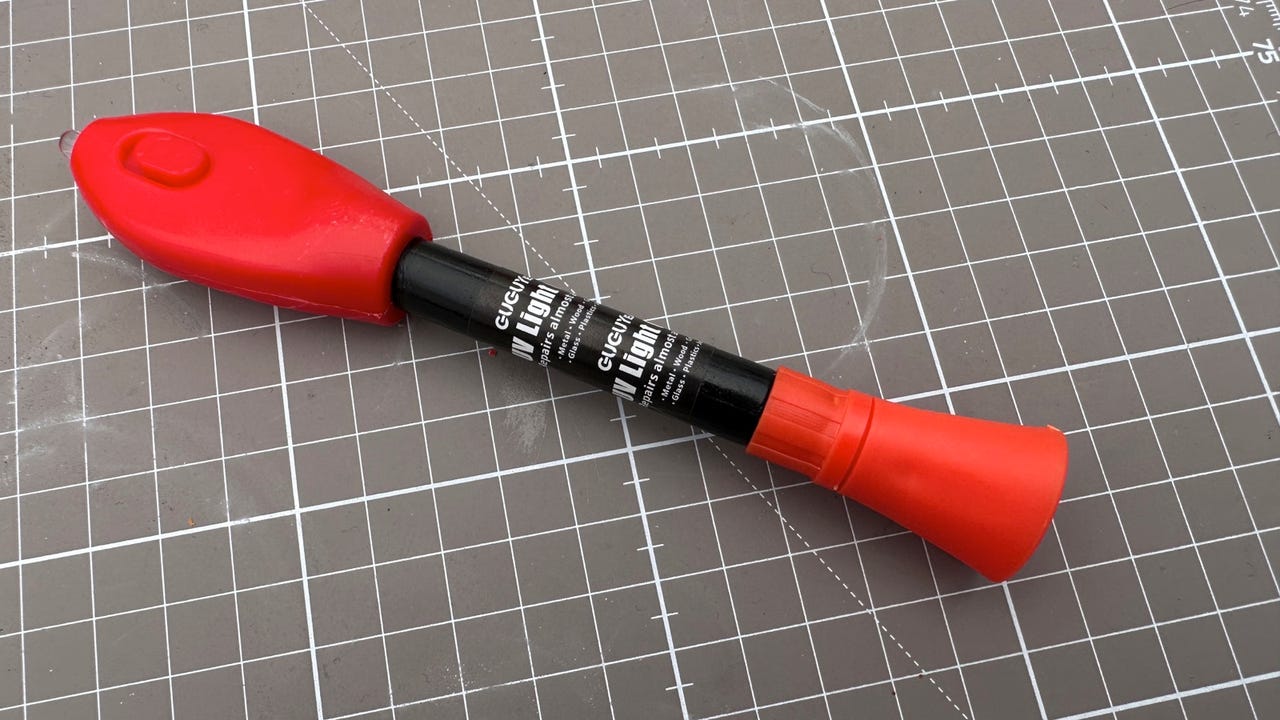This stuff is better than super glue

UV glue pen complete with UV light Adrian Kingsley-Hughes/ZDNET
Broken plastics are a fact of life these days. Plastics tend to break either through being dropped or misused, or through old age.
My weapon of choice in the war against waste and sending things to the landfill has been cyanoacrylate adhesive — this stuff goes by many names, such as Crazy Glue, instant glue, power glue, or superglue — and on the whole it's pretty good stuff.
Also: You're using super glue all wrong
But it's far from perfect.
I find the performance of cyanoacrylate adhesives varies a lot. It sticks well to some things, but not so well to other things. Also, its repairs last well at room temperature, but using it to repair something that's going to be in a hot environment (such as a greenhouse) or cold environment (such as a refrigerator) can be disappointing.
And after decades of using cyanoacrylate to repair stuff, I'm still wary of it. It gets everywhere, and while its performance might be subpar on some materials, you can be certain that there's one thing it sticks to really well, and that's human skin.
Also: My favorite electric screwdriver for heavy-duty jobs
And you definitely don't want to get super glue in your eyes.
A few people have mentioned that I should try UV curing adhesive for repairing things, so I gave it a go.
And I'm impressed.
Note: The kit above has different branding to the one I'm using (and comes with refills) but the resin and UV light are exactly the same.
This kit I'm recommending comes with a small UV light, so you don't need to worry about buying that separately.
Unlike cyanoacrylate where you apply the adhesive and you have seconds to work before it cures, the UV resin doesn't cure until you apply UV light to it (oer expose it to direct sunlight), so it gives you more time to work.
Curing UV resin with a small UV light Adrian Kingsley-Hughes/ZDNET
Also, because the resin is thicker, you can use it to build up the repair better and more easily than with cyanoacrylate (you can add some baking soda to cyanoacrylate to achieve the same result, and it does make for a stronger bond, but again it can get messy).
UV resin also eliminates you accidentally gluing your face to whatever you're repairing. Don't think you can suddenly find your face glued to something? Think again!
Also: This $11 gadget is a must-have for aging eyes
Another application that UV resin glue is ideally suited for is strengthening or reinforcing low-voltage wires. For example, take this charging cable for my amazingly useful label maker. The cable is looking a bit bent out of shape by constant stress.
The strain relief on this cable isn't really relieving the strain on the wire Adrian Kingsley-Hughes/ZDNET
Ideally, I'd pop some heat-shrink tubing over this, but I can't get any that will fit over the connector and shrink down far enough to hold onto the wire.
But not to worry, I can apply some UV resin onto the stressed area (I apply a thin layers, cure it, and apply a few more layers rather than apply one thick layer).
Applying some UV resin onto the stressed area Adrian Kingsley-Hughes/ZDNET
And then cure the resin using the UV light.
And here it is after a few layers have been applied and cured. Job done!
I've experimented with UV resin adhesives on a number of different materials, with impressive results. They seem to work much better for repairing things that are going to be subjected to heat and cold, subjected to flexing, and it's great for building up material when something has broken when the plastic has shrunk (which happens over time).
Also: This USB-powered soldering iron is amazing
One drawback is that UV resin relies on UV light to cure, so wherever you apply it, you will need to be able to get the light on it to cure it. Bear this in mind as it makes it unsuitable for some applications.
For example, if you're sticking something down, adding the resin between two layers isn't going to work because the UV light can't get at the resin and it won't cure.
Also: USB port problems? This handy kit helps you troubleshoot for under $25
But overall, I'm impressed. It doesn't fully replace cyanoacrylate adhesive, but it's another very useful tool in the toolbox.
And it's fast become an indispensable tool.

